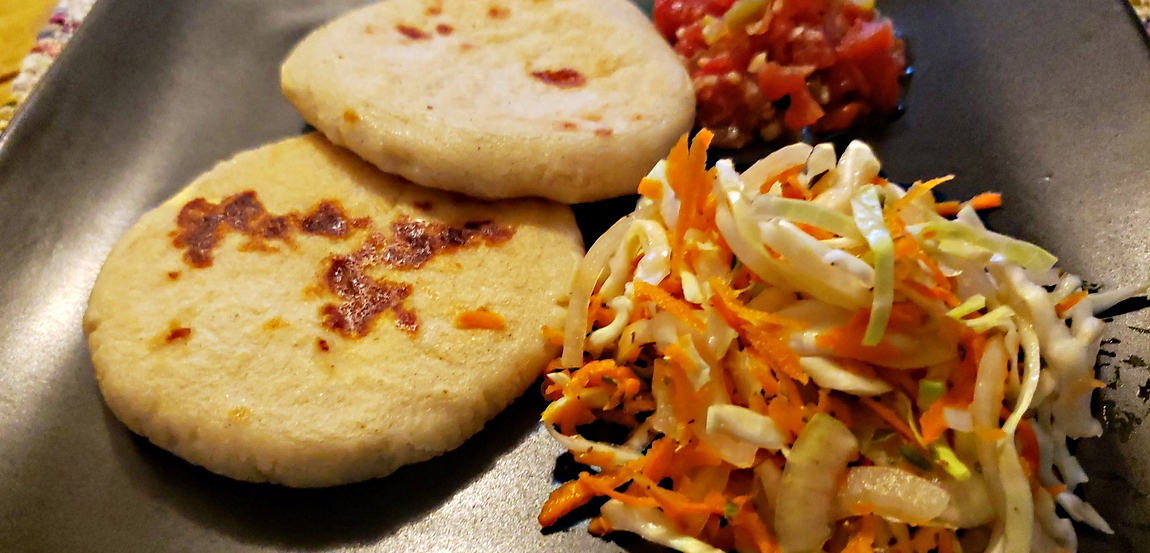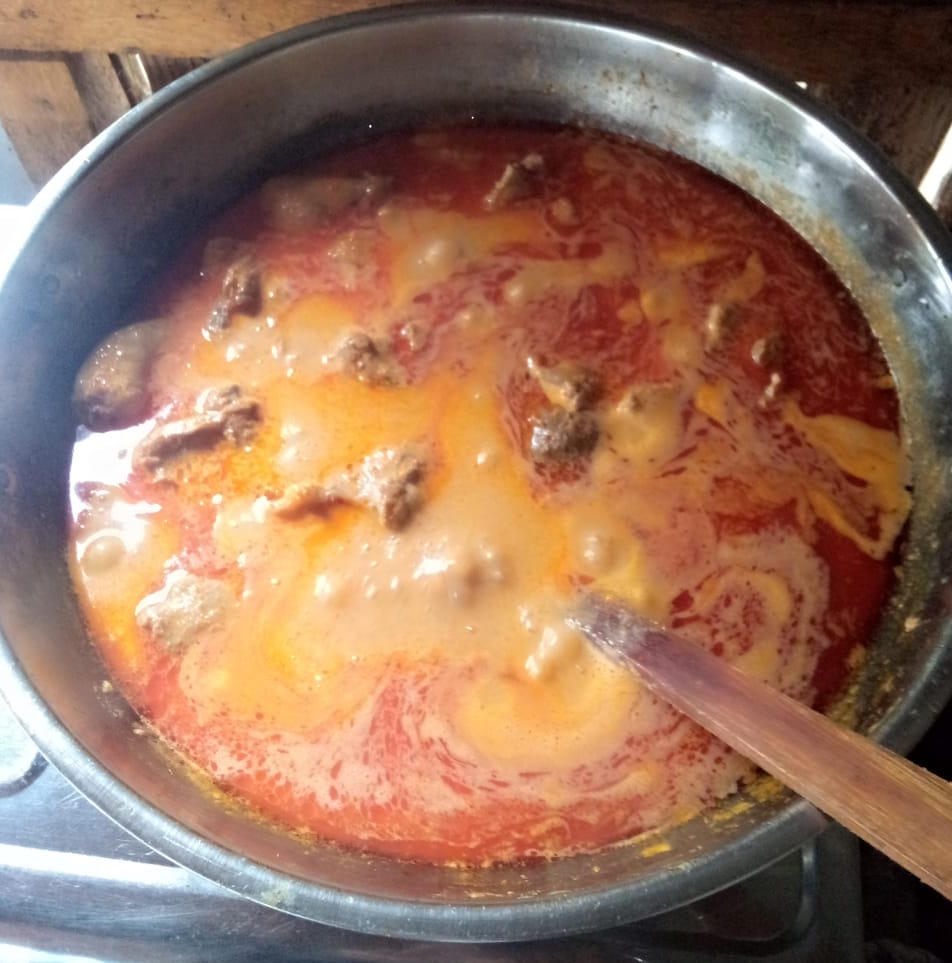Our Recipe of the Month is for Pupusas and Curtido. A street food staple, pupusas are cheese-filled "corn pancakes." Served with sides of curtido salad and tomato salsa, they are a satisfying treat.

Pupusas are found in several countries in Meso-America, and they are considered the national dish of El Salvador. Traditionally pupusas are eaten by hand. Pupusas are made from nixtamalized corn flour. This particular corn flour is known as masa harina and can be readily found in supermarkets here. Nixtamalization is the process of soaking and cooking corn flour in limewater (water made from calcium hydroxide, not lime juice). This process has numerous benefits including making the corn flour more aromatic and flavorful, the nutrients in the corn more bio-available (more nutritious), and lastly, healthier as it significantly lessens the amount of potential aflatoxins. When you add boiling water to the masa harina, you will be treated to a very lovely aroma.
Archeological and linguistic research suggests the origins of pupusas are pre-Columbian, although there seems to be some nationalistic disagreements on whether the origin is El Salvadorian or Honduran. The word means "swollen" in both the Pipil language (El Salvador) and Nahuatl (Honduras) languages. It seems that El Salvador has the better claim as purported implements for making pupusas were found at the Joya de Cerén site (200 - 600 AD), a site that was frozen in time by being covered with volcanic ash (much like Pompei). These original pupusas were crescent-shaped rather than round disks which are the style found today. Pupusas were not known internationally until the emigration of many Salvadorians to the US during the Salvadorian Civil War in the 1980s. As is typical with emigres from just about anywhere, they brought their food traditions with them. In America, they became ubiquitous food truck and street food. In 2011 the English Guardian newspaper declared pupusas to be "New York’s Best Street Food". Since 2005, there has been an official National Pupusa Day in El Salvador. In 2007 in celebration of this auspicious day, the world's largest pupusa was made which measured more than 10 feet in diameter and weighed 280 pounds! In 2015 in the Salvadorian town of Olocuilta a pupusa was made that spanned 14 feet 9 inches, and this is the official Guinness Book of Records titleholder to this day.
Pupusas can be filled with meat, cheese, beans, vegetables, and whatever else is at hand. The most basic recipe (and the recipe we present here) is a cheese-filled pupusa. In El Salvador the cheese of choice is quesillo which is somewhat similar to Italian mozzarella. We used Oaxaca cheese but found it lacked the desirable stringiness of mozzarella, and most English language recipes suggest using mozzarella. Black beans (Frijoles Negros) would seem to be a good addition to or substitution for cheese, but being the first time I tried making pupusas, I wanted to keep things simple. Unless you are well-practiced in making pupusas, their assembly requires some patience.
When water is added to masa harina it creates a somewhat grainy dough. If an insufficient amount of water is added to the flour, the pupusas will crack when they are formed into disks before and after filling them with cheese. Fortunately, you can add water to the dough at almost any stage. When forming the balls (the first step), I wet my hands, and this additional water prevented the pupusas from cracking the first time they are flattened into disks. After adding the cheese to the top of the disks and then folding the edges of the disks upwards (and pinching the dough together to seal in the cheese), I once again wet my hands when reforming the pupusas into balls before their final flattening into disks. If you do get cracks you can press them out of the pupusas with a wet finger. America's Test Kitchen came up with a novel approach to forming pupusas, and I used this process with one alteration. They suggest drawing a 4-inch circle on a gallon (probably could use a quart size too) sized food storage (aka Ziploc) bag. They then cut along three edges of the bag with scissors (including removing the top with the closure). The ball of masa is placed between the plastic and then using a flat-bottomed glass pie plate or glass bowl you can flatten the ball to the correct size (four inches). The one thing I did differently is that when flattening the dough ball the first time (before the pupusa is filled) I pressed it to be about 5 inches in diameter which made it easier to fill with cheese.
One thing to note about making pupusas is whether you bake them, fry them "dry" or fry them in oil, they will be fully cooked before they turn completely brown. Typically, (see the pictures) there will be splotches of brown, but most of the pupusa will remain white. I tried baking the pupusas but the cheese started expanding and escaping before the surface turned uniformly brown. I didn't try frying them in oil, as the tiny slightly-burnt areas that result from dry-frying the pupusas are supposed to add greater flavor.
Pupusas are typically served with curtido salad and a side of curtido. Authentically curtido is a fermented (like saurkraut and kimchi) cabbage-based salad, but most recipes substitute for the sake of time and convenience a quick-pickle version, and I followed this choice. The salsa can be any red salsa you like.
Pupusa Ingredients:
- 2 Cups of Masa Harina
- 2 Cups of Boiling water
- 1 Tablespoon of oil (your choice)
- 1 Tablespoon of salt
- 10 oz of cheese (Quesillo, Oaxaca, Mozzarella, Jack or some other melty cheese)
Pupusa Preparation:
- If using the method described above, make your template out of a food storage bag.
- Add 2 cups of Masa Harina to a mixing bowl.
- Add boiling water, salt, and oil to the bowl.
- With a stiff spoon mix everything until all the masa is thoroughly wet. Add more water if necessary.
- Let dough rest for 20 minutes.
- Grate or pulverize the cheese in a food processor.
- On a baking sheet, divide the cheese into 8 equal portions.
- Form the dough into eight balls with your hands. Keep your hands wet with water.
- Using the method described above (or with your hands) flatten the dough balls into 5-inch disks.
- Place cheese in the middle of a disk and fold up the sides pinching the dough together.
- Roll the dough in wet hands until you have a ball.
- Flatten the dough balls into a 4-inch diameter pancakes.
- Wipe a non-stick skillet with some oil and fry both sides of the pupusas on medium-high until you achieve some browning.
Curtido Ingredients:
- 1/4 head of green cabbage shredded
- 2 medium carrots peeled and either shredded or cut into matchsticks
- 1 medium onion cut in to small slices
- 1 cup of water *
- 1/2 cup of cider or white vinegar
- 1 tablespoon of salt
- 1 teaspoon of dried Mexican oregano (or common oregano)
* Note: if you desire less crisp cabbage, you can soak the cabbage in boiled water for 2 minutes.
Curtido Preparation
- Mix the water, vinegar, oregano, and salt in a bowl until the salt is dissolved.
- Pour the liquid over a bowl of cabbage, carrots, and onion.
- Mix thoroughly.
- Store in refrigerator for 1 hour or more.
- Drain liquid from the curtido.
Buen provecho!
Recipe by T. Johnston-O'Neill
Photos by Shari Johnston-O'Neill









